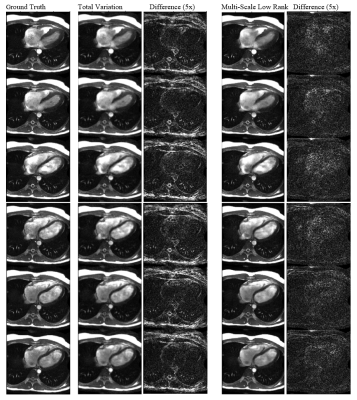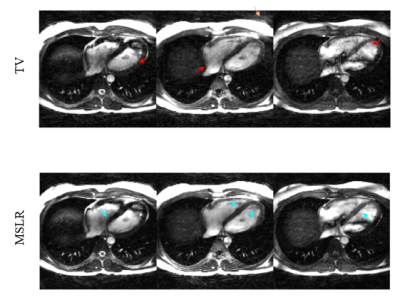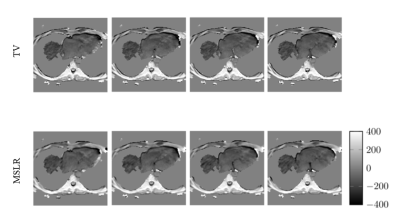1172
Multi-Scale Low-Rank Reconstruction for Phase-Cycled Projection-Reconstruction bSSFP Cardiac Cine and BMART-Generated B0 Maps1Electrical Engineering, Stanford, Stanford, CA, United States, 2Medical Biophysics, Western University, London, ON, Canada
Synopsis
For banding-free bSSFP cardiac cine, a highly-accelerated projection-reconstruction sequence acquires three phase-cycles within a short breathhold. Data is also acquired on the rewinds, enabling generation of B0 maps using BMART, which are used for phase-cycle combination. We show that this data is well-captured by a multi-scale low-rank (MSLR) model, which recovers the normal and rewind images from the aggressively-undersampled data with less streaking and blurring than total-variation-regularized ESPIRiT. In addition to improving the phase-cycle component images, MSLR facilitates generation of temporally-resolved B0 maps with good SNR. Together, these two improvements result in the final, field-map-combined cine images having high quality.
Introduction
For banding-free bSSFP cardiac cine, a highly-accelerated frequency-modulated projection-reconstruction (PR) sequence can be used to acquire three phase-cycles within a short breathhold.1 In that work, a spatial and temporal total-variation regularizer was used to support the aggressive undersampling, but the reconstructed images show some loss of resolution and residual streaking artifacts. Also acquiring data during the gradient rewinders facilitates generation of a B0 field map using BMART (B0 mapping using rewinding trajectories) without an additional acquisition.2 This enables inclusion of only passband signal and exclusion of stopband signal and near-band flow artifacts during phase-cycle combination.3 Since the rewind data is even more undersampled than the normal readout data, however, all cardiac phases were averaged before calculating the field maps to achieve adequate SNR. This results in errors in the field-map combination in regions where B0 changes considerably over the cardiac cycle.A multi-scale low-rank (MSLR) framework has recently been proposed to reconstruct volumetric dynamic images from ungated acquisitions where each frame is extremely undersampled.4 Here, we apply MSLR reconstruction to breathheld, cardiac-gated phase-cycled 2DPR datasets to exploit the structure along the temporal and phase-cycle dimensions.
We hypothesize that MSLR is appropriate since these datasets exhibit different dynamics at different spatial scales – background tissues are mostly static due to breathholding, the banding gradually progresses through the images every three RR intervals, the heart beats every cardiac cycle, and artifactual near-band flow signal changes quickly and unpredictably. If the model can represent frequency-modulated cine data with a small number of basis vectors, MSLR reconstruction may better suppress undersampling artifacts without overregularization. In addition, we illustrate the feasibility of generating temporally-resolved B0 maps with good SNR by also reconstructing the rewind images using MSLR.
Methods
The sequence described in [1] is used to acquire a prospectively-undersampled PR cine dataset with reduction factor R=7.1, including both normal readouts and rewind data for BMART. In addition, for evaluation of the reconstruction relative to a ground truth, Cartesian data with R=2 from [5] is reconstructed using ESPIRiT and inverse-gridded to the PR trajectory, providing a fully-sampled dataset. This data is then retrospectively undersampled using the sampling pattern of the prospectively-undersampled PR data. Since the effective field-of-view of the Cartesian data is approximately half as large due to the anti-aliasing filter, half the lines are further removed to approximate the reduction factor.The cardiac phases of the three effective phase-cycles are concatenated – the frequency-modulation scheme in [5] results in the phase-cycling changing smoothly between cardiac phases and between the last cardiac phase of one effective phase-cycle and the first cardiac phase of the next. The MSLR code (https://github.com/mikgroup/extreme_mri by Ong, et al.4) is then used to reconstruct Ncardiac phases*Neffective phase-cycles frames. Block widths of 16, 32, 64, and 128 are used as the spatial scales for the retrospectively-sampled data while 11, 22, 44, and 88 are used for the prospectively-undersampled data due to the lower spatial resolution (i.e., the physical sizes of the blocks are maintained).
Both datasets as well as the rewind data from the PR acquisition are also reconstructed with ESPIRiT with spatial and temporal $$$\ell_1$$$ total-variation (TV) regularization for comparison. For both methods, the regularization parameter is heuristically determined. Finally, the phase-cycle images from the retrospectively-sampled data are combined using root-sum-of-squares.
The normal and rewind images reconstructed from the prospectively-undersampled PR acquisition are FFTed and a time series of B0 maps are estimated form the resulting k-space data using BMART.2 The phase-cycles are complex-summed and a sliding window two cardiac phases long trades off some temporal resolution of the field-map time series for the SNR of the maps. Field-map combination3 is used to combine the phase-cycles in the final cine images.
Results
On the retrospectively-sampled dataset, MSLR maintains detail while suppressing undersampling artifacts and noise; this results in the difference from ground truth being largely unstructured (Figure 1) and a mean-squared-error 32.6% lower than with TV.For the PR dataset, in the phase-cycle component images, MSLR suppresses streaking and maintains detail better than TV (Figure 2). B0 maps estimated from MSLR-reconstructed normal and rewind data appear more smoothly varying and higher SNR than those from TV (Figure 3). The final field-map-combined MSLR images have reduced streaking and flow artifacts and less blurring than TV (Figure 4).
Discussion and Conclusion
We show that the MSLR framework designed for continuous, non-gated acquisitions is also well-suited to cardiac-gated frequency-modulated bSSFP cardiac cine. It suppresses streaking and maintains detail better than TV. Note that TV is used as the comparison since, for PR data, incorporating phase-cycle-consistency regularization5 did not result in noticeable improvement over TV alone.MSLR also facilitates estimation of temporally-resolved B0 maps from the cine dataset with good spatial and temporal resolution and SNR. The final field-map-combined images are of much better quality than those reconstructed using TV. Artifactual flow signal is localized to near the bands in the individual phase-cycle images reconstructed with MSLR, so field-map combination excludes these artifacts more effectively than for TV-reconstructed images. Therefore, the improved combined images may result from both higher-quality component images and less-noisy field maps.
MSLR’s ability to facilitate free-breathing frequency-modulated bSSFP cardiac cine also merits investigation.
Acknowledgements
Thank you to GE Healthcare, NIH R01 HL127039, NSF GRFP, and the Hertz Foundation for their support.References
1. Datta A, Nishimura DG, Baron CA. BMART-enabled field-map combination of phase-cycled projection-reconstruction cardiac cine for banding-free balanced SSFP. In Proceedings of the ISMRM Virtual Conference, Online, August 2020. p. 3407.
2. Baron CA, Nishimura DG. B0 mapping using rewinding trajectories. Magn Reson Med 2016. doi: 10.1002/mrm.26391
3. Datta A, Nishimura DG. Field map combination method for multiple-acquisition bSSFP. In Proceedings of the 25th Annual Meeting of ISMRM, Honolulu, May 2017. p.454.
4. Ong, F, Zhu, X, Cheng, JY, Johnson, KM, Larson PEZ, Vasanawala, SS, Lustig, M. Extreme MRI: Large‐scale volumetric dynamic imaging from continuous non‐gated acquisitions. Magn Reson Med. 2020; 84: 1763– 1780. https://doi.org/10.1002/mrm.28235
5. Datta, A, Nishimura, DG, Baron, CA. Banding-free balanced SSFP cardiac cine using frequency modulation and phase cycle redundancy. Magn Reson Med. 2019; 82: 1604– 1616. https://doi.org/10.1002/mrm.27815
Figures



